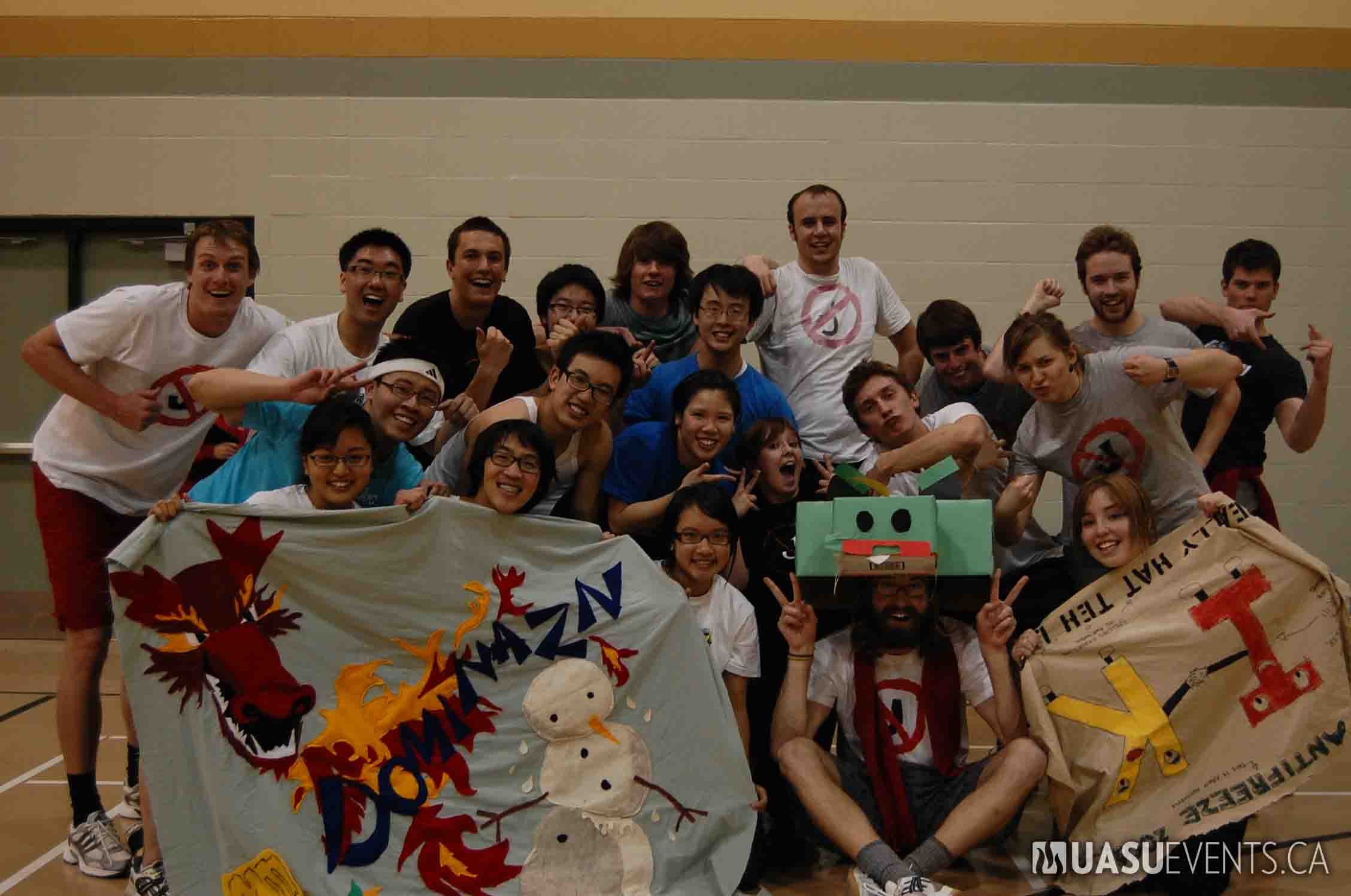
The Official Student Winter Games
A History of Antifreeze
Antifreeze informally began due to the accumulation of lawsuits that University had gotten about injuries from unshoveled sidewalks. The Winter of 1913 had been an exceptionally snowy and Henry Marshall Tory had grown tired of having to recruit professors to shovel when they weren’t lecturing. He was quoted saying to an assembly of students: “... seldom is it given a man or group of men to lay the foundations of great institutions, and while doing so, to blaze a path into which an established order shall compel other men to walk.” He called upon those present to take up shovels and make the University walkable once more. Tory was known for being charismatic and verbose, and this speech was no exception. His call to arms worked well, but he needed a better system if he wanted to get consistent free labour from his students. He decided to make a yearly event upon the first snowfall of the year, called aduratus. At the event students would form shovelling teams in which they would be ranked on how much snow they moved. The winners were given enough money to Dew-Yeti’s, the local spot-to-be, to have an extravagant night on the town. Aduratus worked well into the 1920s, but as Nelly Furtado so elegantly sang to us “all good things (must) come to an end.”
As the 1920s began to die, so did the University's obsession with latin. The beginning of the 1930s came with a new name for aduratus, which was Antifreeze. Also, the event began to shift away from shovelling snow because the Tuition Raise of 1927 gave the University the appropriate budget to hire a facilities team. Instead, the elected president of the Students Union would go hide on campus and teams would gather on a dark campus in a great effort to find the him/her, called “Include the POTSU”. This event would lay the foundations for what we recognize to be the modern “Journey to the North Pole”.
1940s and 50s is where Antifreeze began to show its true coolness. Antifreeze expanded from a single night to a span of days where challenges began to resemble the modern Antifreeze events. Of particular note, is the sled based race from the late 1950s that continued into the 1960s called “When Halls Freeze Over.” Sidewalks between Assiniboia and Athabasca halls were flooded to provide a low friction surface. Teams were to build sleds and move their teammate the furthest with a single push. The consequences of this event were put best by songbird of the early 2000s, Nelly Furtado, when she sang “Looks like what goes around comes around.” The lawsuits began sliding in once more. Tensions rose between the Antifreeze organizers and the University President as cold threats were exchanged. The ground was set for the cool Summer of ‘69.
Antifreeze ‘69 is the year the organizers got cold with their responses to the University. Finally fed up with the yearly post-Antifreeze lawsuits, President Jim Johnson and Chairman Jody Smith made the executive decision to suspend all Antifreeze related activities indefinitely. In response the teams and organizers put aside their differences and executed “Operation on Thin Ice.” Protesters sat outside the administration office on a layer of thin ice to symbolize their feelings toward the University’s decision. Due to the pressure from the protestors, Jimmy quit and Jody got married (which grew her heart three sizes). They should’ve known they would never get far suspending Antifreeze.
Surprisingly, not much is known about Antifreeze through the 1980s and 90s. Archaeologists speculate the event spanned multiple days with events that involved eating, running, and staying warm. Evidence collected from an archaeological dig suggests that teams were required to build a sled for use during the event, but we cannot be certain. What we are certain of is that is the first years the prizing resembled what we use today, a ski trip.
Antifreeze in the 2000s to now are a bit Wonky. Some participants report that a lack of caffeine has coincided with a near death experience, but no causal factor has yet to be found. The events have remained consistent, but the details have varied. All things considered, we have preemptively hired a team of investigators to freeze this threat in its tracks. We will keep participants of all caffeine related dangers as the event progresses.
From shovelling sidewalks to building sleds not much has stayed the same for Antifreeze over the years. However, what has stayed the same is the love for our cool participants. People say we are too frigid to love anything like we do Antifreeze and her players. However, we remain chilled in the face of adversity. I think Nelly Furtado communicates our feelings towards Antifreeze best when she says “I’ll never build you up only to tear you down… I love you the way you are.” Stay frosty my friends.
Highlights of AntiFreeze
Throughout the long history of AntiFreeze champions have emerged every year from the icework. Without these champions AntiFreeze would not be the great battle across campus is it is today. So pay attention and maybe you can learn something from their example and join them in the Wall of Fame.
The first team to set a record was George Stanley from the class of 1929 with his team the “Red & White Maple Leafs” with their revolutionary new flag. Their new design of their flag broke the ice across Canada. When other AntiFreeze teams saw their flags, they felt commanded to stand and sing. By freezing teams in their tracks they won every single event by an avalanche. Legend has it their flag was so good that the University of Alberta President hung it on campus somewhere. Where some say it still blows in the wind to commemorate the blaze of glory the “Red & White Maple Leafs”.
Myer Horowitz created a team only know as “The Theatre”, where his performance in the AntiFreeze of 1959 was so devastating and inspiring it helped launched his career as the 9th president of the UofA. Horowitz with his team “Theatre” excelled at using their skills in B.Y.O.B, which stood for build your own building at that time. Myer with his team of Education students decided to build a space for children to perform ballet and piano recitals to their parents. To ensure their win, they used their education background to compel elementary students to attack and demolish the buildings of other teams. The president at the time was so impressed with the precision strikes and Myer’s charm that he presented Myer with a throne made of iron. This iron throne was the one Myer used during all his meetings as president.
Ray Muzyka with his team of Doctors named the “Stars Mass Age” completed reinvented AntiFreeze in the early 1990s by completing destroying all the other teams in an epic Larping session that last the entire week. During the Larping session across campus they were the only team that stuck to their roles for the entire week, never getting out of character, even for class. Their only competition that year was a team known as “Blizzard” whose strategy and loot were better than Ray’s yet, by weaving a complex story during the last 3 days that made all other teams root for Ray and their ragtag team of doctors. By combining with other teams in a final standoff in Bio Sci, Ray’s team managed to defeat “Blizzard” through a frozen spell that just made their opponents want to “let it go”.
Who is next to set a epic record during this year’s AntiFreeze? Maybe it’s your team, you don’t know unless you try. So let your team name be on next year’s AntiFreeze game package for all to talk about. So let's see if your team has the guts to knock your opponents out cold and remember don’t have a meltdown or you could end up taking your money out of the snow bank.

Phone
780-492-1480
Email
antifreeze@su.ualberta.ca
Students' Union Executive and Administrative Offices
Room 2-900
Students' Union Building
University of Alberta
8900 - 114 Street NW
Edmonton, AB
T6G 2J7
